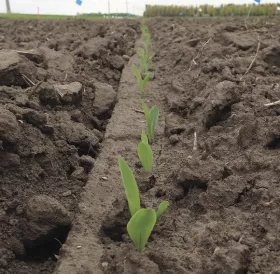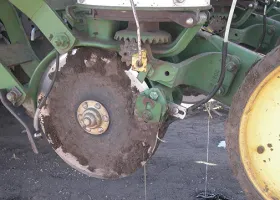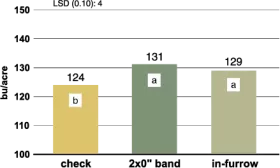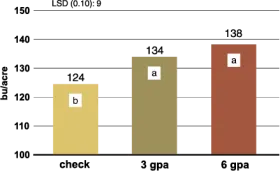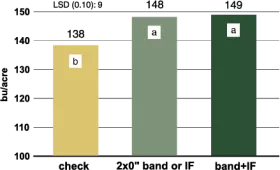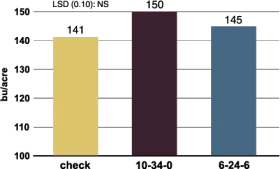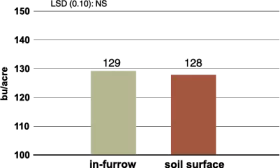In individual trials (site-years), corn grain yield response did not always occur among fertilizer treatments.
Averaged across eight site-years, band- and in-furrow-applied 10-34-0 increased yield 5 to 7 bushels per acre (4% to 5%),
Figure 1. Corn grain yield between band and
in-furrow application of 10-34-0, Carrington, 2008-16
(8 site-years).
compared with the untreated check (Figure 1). Yield between the two starter fertilizer application methods was statistically similar.
Plant stand was similar between band (30,100 plants per acre) and in-furrow (28,800 plants per acre), with 10-34-0 application rates ranging from 2.5 gallons per acre (gpa) up to 6 gpa. Averaged across five site-years with 10-34-0 rates of 5 to 6 gpa, the number of days from corn seed planting to plant emergence was similar among the check, 2x0” band and in-furrow application of fertilizer (data not shown).
Also, ear silks emerged slightly earlier (one to two days) with starter fertilizer application, compared with the check. Averaged across 11 site-years, grain harvest moisture was similar and test weight increased slightly with band applications of 10-34-0, compared with the check (Table 1).
Table 1. Corn grain harvest moisture and test weight with 10-34-0 starter fertilizer, Carrington, 2008-16
(11 site-years).
| |
%
|
lb/bushel
|
|
2x0" band
|
20.1
|
55.0
|
Soil P: 3-20 ppm (very low to very high). 10-34-0 application rate (gpa): 2.5-12.
Figure 2. Corn grain yield between 10-34-0 application
methods, Carrington, 2013-15 (3 site-years).
Averaged across three site-years, yield statistically increased with band-applied 10-34-0 compared to the check, while broadcast-applied 10-34-0 had similar yield as the check (Figure 2). This supports the recommendation that banded P applications are more efficient in producing yield, compared with broadcast P applications for corn.
Figure 3. Corn grain yield between rates of in-furrow
applied 10-34-0, Carrington, 2007-16 (6 site-years).
The banded fertilizer rate was one-third less compared with the broadcast rate in the trials. The broadcast fertilizer was applied immediately after planting (PRE) without mechanical incorporation in 2013. The broadcast fertilizer was preplant applied and incorporated (PPI) in 2014-15.
Yield increased with 3 and 6 gpa of in-furrow-applied 10-34-0, compared with the check, averaged across six site-years (Figure 3); however, yield was similar between fertilizer rates.
Averaged across three site-years, yield did not improve with a split application
of 10-34-0 using band plus in-furrow (IF) placement, compared with similar rates of only band or in-furrow application of fertilizer (Figure 4).
Averaged across three site-years, a yield advantage did not occur with deep-band- or deep-band plus in-furrow-applied 10-34-0, compared with band-applied fertilizer at planting (Table 2). The deep-banded fertilizer was applied at the 5- to 6-inch depth in a 0.75- inch band in October or November 2010 and 2012, and May 2013 using strip tillage. Deep-banded plus in-furrow-applied 10-34-0 rates were one-half of total P for other treatments.
Table 2. Corn grain yield with deep-band (5-6 inches deep) applied 10-34-0, Carrington, 2010 and 2012-13 (3 site-years).
|
10-34-0 application
|
Grain yield
|
| |
bu/acre
|
|
Check
|
170
|
|
Deep band
|
172
|
|
Deep band followed by in-furrow
|
171
|
|
2x0” band
|
176
|
|
LSD (0.10)
|
NS
|
Soil P: 5-10 ppm (low to medium). 10-34-0 total application rate (gpa): 2010=6, 2012-13=12.
Figure 4. Corn grain yield between 10-34-0
fertilizer application methods, Carrington, 2014-16
(3 site-years).
At similar rates of in-furrow-applied P, the three site-year yield average with low-salt fertilizer 6-24-6 was similar to 10-34-0 (Figure 5). Also, plant stands were similar between the two fertilizers (data not shown). Potassium (K) soil levels in the trials were high to very high.
Averaged across four site-years, yield was similar with soil surface application (near seed furrow) of 10-34-0 at planting compared with in-furrow application (Figure 6). Rainfall among the four years, ranged from 0.1 to 0.4 inches, three to five days following surface application of 10-34-0 (North Dakota Agricultural Weather Network). Rainfall is desirable to move the fertilizer below the soil surface to be accessed by the developing root system of corn seedlings.
Figure 5. Corn grain yield between in-furrow applied
10-34-0 and 6-24-6 fertilizer, Carrington, 2014-16
(3 site-years).
Summary
■ Corn grain yield was similar with band and in-furrow 10-34-0 application, and starter fertilizer increased yield, compared with the untreated check. Also, test weight increased slightly with band application of 10-34-0, compared with the check.
■ Yield was similar between the 3- and 6-gpa rates of
in-furrow-applied 10-34-0.
■ Yield did not improve with a split application of 10-34-0
using band plus in-furrow placement, compared with similar rates of only band- or in-furrow-applied fertilizer.
Figure 6. Corn grain yield between 10-34-0 in-furrow and soil surface application methods, Carrington, 2017-18 and 2020-21 (4 site-years).
■ Deep-band (5 to 6 inches deep, fall or spring placed) or deep-band plus in-furrow-applied 10-34-0 had similar yield as the planting-time band-applied fertilizer.
■ Yield was similar between in-furrow-applied 10-34-0 and the low-salt fertilizer 6-24-6.
■ Yield was similar between in-furrow- and soil-surface-applied 10-34-0.
Reference
Franzen, D.W. 2017. Soil fertility recommendations for corn. NDSU Extension publication SF722 (Revised). http://tinyurl.com/NDSUCornFertility
Research was partially supported by the North Dakota Corn Utilization Council.
